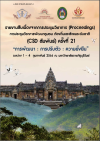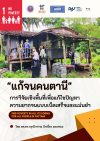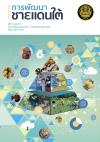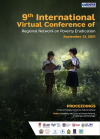บทความทางวิชาการ

ปัญหาและความต้องการในการพัฒนาอาชีพแปรรูปอาหารและขนมพื้นบ้าน และตัดเย็บของชุมชนบ้านกลาง ตําบลบ้านกลาง อําเภอปะนาเระ จังหวัดปัตตานี
จิรัชยา เจียวก๊ก, สวัสดิ์ ไหลภาภรณ์ , อาริดา ทิ้งน้ํารอบ, และอานีรา แวเด็ง
บทคัดย่อ
การวิจัยครั้งนี้มีวัตถุประสงค์เพื่อศึกษาปัญหาและความต้องการ และผลจากการแก้ไขปัญหาและความต้องการของชุมชนในการพัฒนาอาชีพการแปรรูปอาหารและขนมพื้นบ้านและกลุ่มตัดเย็บชุมชน บ้านกลาง ตําบลบ้านกลาง อําเภอปะนาเระ จังหวัดปัตตานี จากผู้ให้ข้อมูล ผู้ที่ประกอบอาชีพแปรรูปอาหารและขนมพื้นบ้าน จํานวน 8 คน และผู้ที่ประกอบอาชีพตัดเย็บ จํานวน 9 คน รวมทั้งสิ้น จํานวน 17 คน เครื่องมือที่ใช้เป็น แบบสัมภาษณ์กึ่งโครงสร้าง แบบสังเกต และบันทึกรายรับรายจ่ายครัวเรือน วิเคราะห์ข้อมูลโดยการวิเคราะห์เนื้อหา ผลการวิจัย พบว่า (1) ปัญหาของอาชีพการแปรรูปอาหารและขนมพื้นบ้านในชุมชนน้ัน ได้แก่ การขาดอุปกรณ์ ด้วยอุปกรณ์บางส่วนชํารุด และสถานที่ในการประกอบอาหาร ไม่ถูกสุขลักษณะ จึงต้องการอุปกรณ์ท่ีตรงต่อความต้องการในการประกอบอาชีพ และการปรับปรุงสถานที่ประกอบอาหารให้ถูกสุขลักษณะ ส่วนปัญหาของอาชีพการตัดเย็บในชุมชน ได้แก่ การขาดความรู้ในการออกออกแบบชุด และขาดอุปกรณ์ในการประกอบอาชีพตัดเย็บ จึงต้องการความรู้ในการออกออกแบบชุด และอุปกรณ์ในการประกอบอาชีพตัดเย็บ (2) ผลจากการ แก้ไขปัญหาและความต้องการของชุมชนในการพัฒนาอาชีพการแปรรูปอาหารและขนมพื้นบ้านและกลุ่มตัดเย็บชุมชน ได้แก่ สัดส่วนของรายจ่ายน้อยกว่ารายรับ รายได้เพิ่มขึ้น มีความสะอาดของอาหารที่ผลิต มีทักษะฝีมือออกแบบและตัดเย็บได้ประณีตมากขึ้น
แหล่งเผยแพร่

“แก้จนคนตานี” การวิจัยเชิงพื้นที่เพื่อแก้ไขปัญหาความยากจนแบบเบ็ดเสร็จและแม่นยำ
ผศ.ดร.อรุณีวรรณ บัวเนี่ยว และ คณะ
บทคัดย่อ
ในปี 2566-2567 นี้ มหาวิทยาลัยสงขลานครินทร์ วิทยาเขตปัตตานีได้รับเลือกให้เป็นหนึ่งในเจ็ดพื้นที่ยุทธศาสตร์การแก้ไขปัญหาความยากจนระดับประเทศ (Strategic Research Area: SRA) ภายใต้ชื่อโครงการ “การพัฒนาและยกระดับการจัดการเชิงยุทธศาสตร์เพื่อขจัดความยากจนและสร้างโอกาสทางสังคม: กรณีศึกษาพื้นที่จังหวัดปัตตานี” โดยเน้นการพัฒนาและการแก้ไขปัญหาที่ใช้องค์ความรู้จากการวิจัยและใช้ข้อมูลเป็นฐานเพื่อออกแบบระบบการตัดสินใจ การบูรณาการการทำงานร่วมกันระหว่างภาคีทั้ง 5 คือ ภาคี ภาครัฐ ภาคเอกชน ภาคประชาสังคม ภาคประชาชน และภาควิชาการอย่างเป็นรูปธรรม และการพัฒนาโมเดลเชิงปฏิบัติการแก้จนต้องออกแบบเพื่อสามารถสร้างรายได้และยกระดับคุณภาพชีวิตของครัวเรือน กลุ่มและชุมชนได้อย่างแท้จริง
กูตุ๊ตาลีอายร์: ผลิตภัณฑ์แปรรูปของตำบลตาลีอายร์ อำเภอยะหริ่ง จังหวัดปัตตานี ในปฏิบัติการโมเดลแก้จน Tali-ai Tastes
นุรซาร์ฮิดาห์ อุเซ็ง และ คณะฯ
บทคัดย่อ
แกงกูตุ๊ คือ แกงเนื้อสูตรโบราณที่ชาวมลายูในพื้นที่ 3 จังหวัดชายแดนภาคใต้จะหาทานได้ในช่วงเทศกาลพิเศษ เช่น วันตรุษอิดิ้ลฟิตรี และ วันตรุษอิดิ้ลอัฎฮา หรือที่ภาษามลายูท้องถิ่นเรียกว่า วันรายอเท่านั้น เพราะในช่วงเทศกาลที่กล่าวมาข้างต้นนั้น ในครอบครัวจะมีการเชือดพลีเนื้อสัตว์ เช่น วัว หรือ แพะ แกะ เพื่อจุดประสงค์ในการทำทานให้กับคนยากไร้และเพื่อบริโภคภายในบ้านเรือน แกงกูตุ๊ เป็นแกงที่ทานได้ทุกเพศ ทุกวัย มีส่วนผสมของสมุนไพรและเครื่องเทศที่มีในท้องถิ่นเป็นส่วนผสมหลัก ไม่มีกะทิ ซึ่งถือได้ว่าเป็นแกงที่มีคุณประโยชน์ทางสารอาหารเป็นอย่างมาก การพัฒนาผลิตภัณฑ์แกงกูตุ๊ให้สามารถบริโภคได้นอกจากในช่วงเทศกาลจึงเป็นการรักษาและถ่ายทอดวัฒนธรรมด้านอาหารจากชุมชนมลายูสู่ภายนอก อีกทั้งในตลาดยังไม่มีผลิตภัณฑ์แกงกูตุ๊ในลักษณะการยืดอายุด้วยการสเตอริไลส์วางขายตามร้านต่าง ๆ ทางคณะผู้วิจัยจึงเล็งเห็นถึงช่องทางในการใช้ทรัพยากรธรรมชาติที่มีในชุมชน นั่นคือ สมุนไพร เช่น ขิง ข่า ตะไคร้ ลูกผักชี พริก และอื่น ๆ และพัฒนาผลิตภัณฑ์แกงกูตุ๊ ให้เป็นผลิตภัณฑ์ของชุมชนที่สามารถสร้างรายได้ สร้างการมีส่วนร่วมของคนจน และลดการทำงานนอกพื้นที่ของกลุ่มเป้าหมายครัวเรือนยากจน เพื่อเป็นทางเลือกสำหรับการบริโภคอาหารฮาลาลให้กับกลุ่มลูกค้าเป้าหมายที่มีความสนใจซื้อผลิตภัณฑ์ที่เป็นของฝากของจังหวัดปัตตานี และกลุ่มลูกค้าที่มีความจำเป็นต้องเดินทางออกนอกพื้นที่หรือต่างประเทศแต่มีความต้องการบริโภคอาหารท้องถิ่น
Career Development With Social Capital for Sustainable Development
J. Jeawkok, P. Jeerasathian, S. Laipaporn, T. Kraiprom and N. Kaewsuwan
บทคัดย่อ
This study aimed to 1) investigate the relationship between community capital and financial capital of people in Ban Klang Sub-district, Panare District, Pattani, who are considered poor according to the criteria of Basic Minimum Needs, and 2) formulate equations for predicting the relationship between community capital and financial capital in Ban Klang Sub-district, Panare District, Pattani. The subjects in this study were 41 residents in Ban Klang Sub-district, Panare District, Pattani, who are considered poor according to the criteria of Basic Minimum Needs in 2020. The samples were purposively selected based on the criteria of the research project. The research instrument was 5-point scale questionnaire consisting of 17 items. The statistics used in this study were percentage, means, and multiple regression analysis (Enter method). The results revealed that, firstly, both Kendall Tau Correlation and Spearman’s rho were positive correlations between physical capital and human capital as well as natural capital. In addition, it was also found that there were positive correlations between natural capital and physical capital together with financial capital, natural capital (X3X3), physical capital (X2X2), social capital (X4X4), and human capital (X1X1) affected financial capital at .05 significance level. Indeed, they could predict mathematics model at 52.66% confidence and formulate equations as follows; Raw Score Model ŶŶ = 1.334+.423(X3X3) + .366 (X2X2) + .255(X4X4) + .147(X1X1) Standardized Model ẐYẐY = .394(ZX3 ZX3) + .323(ZX2 ZX2) + .287(ZX4 ZX4)+ .125(ZX1ZX1)
Reducing Poverty and Improving Equity by Using Knowledge of Sufficiency Economy Philosophy in Pakaharang, Pattani, Thailand
E. Ruangrak, S. Chuai-Aree, A. Buaneaw and K. Kwanpetch
บทคัดย่อ
The sufficiency economy concept is a key to improving poverty and reducing the economic susceptibility of the poor. The aim of this study is to reduce the poverty and improve equity by using the model of sufficiency economy philosophy in Pakaharang, Pattani, Thailand. This study is a part of the project on “Area-Based Collaborative Research on Reducing Poverty and Improving Equity in Thailand: A Case Study of Pattani Province Project”. A total of 215 poor households were surveyed based on data from the Thai People Map and Analytics. Then, the eleven poorest families in this village were selected for further analysis in order to understand the knowledge of the sufficiency economy philosophy. Subsequently, we gave the suitable knowledge in sufficiency economy philosophy. Subsequently, we gave the suitable knowledge in sufficiency economy philosophy for each family for four months by focusing on the concept of “poor families have a place to live, food to eat, money to save and invest”. The result shows that these poverty families have dramatically developed better living qualities such as income, food, social acceptance, happiness, knowledge, education, ideas, money management and investment.
Social Capital and Implementation Effects: Participatory Action Research for Poverty Alleviation Through the Earthworm Fertilizer Pilot Project, Mayo District, Pattani Province
A. Aedasong and N. Useng
บทคัดย่อ
Undertaking poverty remains a significant challenge in todays society. It is listed as the first mission in the list of 17 goals in Sustainable Development Goals (SDGs), which are To be incorporated by all developed and developing countries. Thailand poverty rate is rising in recent years. Many provinces in Thailand face poverty and inequality, including Pattani, Thailands top poverty-stricken province. The main objective of this article was to study the social capital available in the community and the impact of the implementation under participatory action research (PAR) for poverty alleviation under the Earthworm Fertilizer Pilot Project in Kor Lae village, Mayo District, Pattani Province, Thailand. Results showed that important social capital leading to the successful implementation process, including; human resources in the community, trust, efficient group representative, and cooperation network. The major outcome that impacts the group level is that community members are self-sustainable in producing organic fertilizers for agricultural use, reducing household expenses, and income-earning from the sale of vermicomposting and other derivable products. Finally, the main outcome which impacts at the social level includes incorporating ready-to-produce equipment with the fertilizer production house, information and knowledge board, learning center on worm manure production that can be a model for other communities.
Poverty Eradication in Pattani: Kor Lae Model
N. Useng, A. Smuseneto and A. Tamkrong